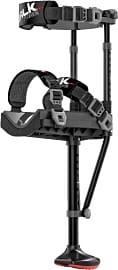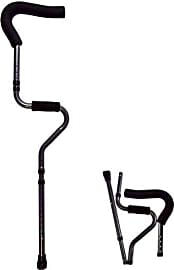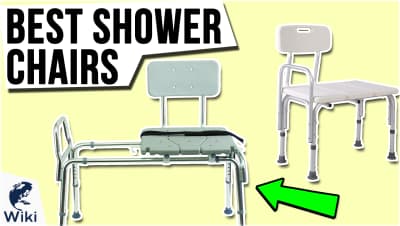The 10 Best Crutches

This wiki has been updated 39 times since it was first published in April of 2015. When you need some support getting around, but don't want to be completely off your feet, a good set of crutches could be your ticket to freedom. Our assortment includes lightweight and budget-friendly options for temporary use, as well as more sophisticated, ergonomic designs to help absorb impacts, reduce irritation and promote a healthy posture for longer-term mobility assistance. When users buy our independently chosen editorial recommendations, we may earn commissions to help fund the Wiki.
Editor's Notes
January 13, 2020:
We removed several options that were no longer for sale, and a few others were bumped off to make room for superior options. Since different body types and physical limitations are better suited for different designs, we made sure to include options for each crutch type: forearm, underarm, and hands-free.
Even though it meant we no longer have a dedicated pediatric option, we decided to remove the Inspired by Drive Pediatric. There just wasn't enough evidence to support its quality or safety, and other pediatric options had the same problem. Fortunately, most of the options on this list also come in child sizes. The PCP Push Button, for example, offers a kids size that fits users as short as 4 feet.
We also wanted to add an option for people who only need one crutch, so we added the Ez2care Adjustable. It can be used by both left and right-handed people, and can also be used forwards or backward, depending on your preference.
Something to keep in mind when using a new pair of crutches is to really make sure they fit correctly. A lot of complaints - in terms of comfortability - are likely due to not properly adjusting the crutch to your body. This should reduce a lot of the chafing and soreness that people experience.
Stability And Support Where It's Needed Most
Additionally, the shape and design of forearm crutches allow for a greater degree of movement than a user would experience using an underarm crutch.
Some people like to be innovative, inquisitive, thoughtful, and are always thinking of ways to circumvent problems, while coming up with applicable solutions and workarounds. This can be true for points of confusion, inventions, and temporary or permanent disabilities. Perhaps you've recently taken an unfortunate tumble down the stairs, have fallen on the street, broken a bone, or perhaps you suffer from a physical difference that would prevent you from having full use of your legs. The last thing you plan to do is give up. You're still going to get around and get things accomplished. For any one of these reasons, crutches are an extremely valuable tool for making the unlikely suddenly possible.
Typically constructed from either hardwoods or metal, crutches are vertical tools designed to support a disabled person when their ability to walk normally has been compromised. Functionally speaking, a pair of crutches reduces the weight load on one's legs, while broadening their support base in order to maintain balance and stability when moving around. By distributing weight towards the forearm and underarm, crutches help to promote upright posture for those with disabilities or paralysis. Crutches also allow the user additional maneuverability in places they wouldn't ordinarily be able to go if they were in a wheelchair.
By supporting upright movements, crutches improve circulation as well as the function of both the kidneys and lungs.
Several different types of crutches are available. The axillary (or underarm) crutch is the most common and is easily adjusted to accommodate a variety of heights. Axillary crutches are used by placing their top pads against a user's ribcage and beneath the armpit. A parallel hand grip is also located below the pads. Axillary crutch users will often place a towel or soft cushioning around the crutch padding to prevent potential armpit injury or nerve damage. The Lofstrand crutch (or forearm crutch) offers increased flexion for the elbow, which allows the arm to bear an increased amount of weight. Platform crutches (or triceps crutches) are known for their built-in troughs that support the forearm at the very top, while a vertical handgrip is placed at the end of the platform. Velcro straps are usually applied around the forearm to keep the platform crutch in place.
Forearm crutches offer several advantages over traditional underarm crutches, with the main advantage being that forearm crutches spread the majority of a user's weight across their entire forearm instead of simply concentrating it around the wrist. This can help to prevent wrist injury. Additionally, the shape and design of forearm crutches allow for a greater degree of movement than a user would experience using an underarm crutch. That being said, the forearm crutch does have a steeper learning curve than the more traditional axillary crutch.
The forearm crutch is preferred in Europe, while the underarm crutch is more common in the United States. One of the underlying reasons for this in the states is that forearm crutches are often associated with permanent disabilities, whereas the underarm crutch has a connotation more aligned with temporary use.
Being Informed Right Out Of The Gait
The type of crutch you choose depends on a variety of factors, including the type of injury or condition you have and the way that injury or condition will affect your gait. Gaits are important to learn when using crutches, as they can help some of your muscles rest while others are working, so finding the right type of crutch to make it as easy on yourself as possible is important.
Comfort is a big deal when using crutches. Depending on your injury, you may have to use one or two crutches for an extended period of time, so ensuring that the pads are properly cushioned, the hand grips are easy to use, and that the crutches are both lightweight and durable will all be integral to your search.
Crutch tips are also important to consider. They should be made from some type of non-slip material to provide superior traction, while also being wide enough to offer dependable support when you move around.
Universal height adjustability also matters, particularly if the intended user for the crutches is a kid who's still growing.
A Brief History Of The Crutch
Evidence of carvings from ancient Egypt dating back to the time of the pharaohs five thousand years ago suggests that crutches have been around for quite a while. The pharaohs of Egypt used these devices to help them get around. Since that time, the design hasn't changed all that much. Tree branches or timber were often used to fashion rudimentary crutches with natural padding to make them more comfortable.
Fast forward a few thousand years and we'll come to the first patented and commercially-produced crutch, developed in 1917 by Emile Schlick.
Fast forward a few thousand years and we'll come to the first patented and commercially-produced crutch, developed in 1917 by Emile Schlick. This early crutch design resembled a simple walking stick with upper arm support. By 1945, A. R. Lofstrand, Jr. patented the first set of crutches with adjustable height, making them fully customizable. Lofstrand's main goal was to assist a disabled person to achieve both normal step motions and balance.
Credit for the design of forearm crutches lies with Thomas Fetterman who used the invention as a way to deal with his prior experience with Polio in the nineteen fifties. Fetterman realized some of the drawbacks with axillary crutches (the potential for slipping, falling, and nerve damage) and developed a crutch with a superior ability to grab the ground, thanks to an improved crutch tip and shock-absorbing gel cap. This crutch went into production in 1988 and is still recommended by orthopedic specialists today.















